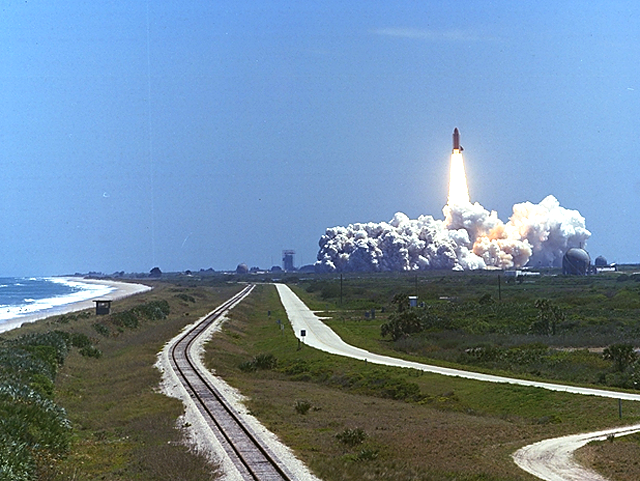
Timeline
From Tragedy to Triumph
There are some events that are so shocking that anyone will remember where he or she was and what they were doing when they happen. January 28, 1986 saw one of these events as Challenger 51L mission lifted off from Kennedy Space Center. One of the seven crew members on board that day was Christa McAuliffe, a high school social studies teacher from Concord, New Hampshire. Christa had been selected from more than 11,000 applicants to participate in the NASA Teacher in Space Project and was scheduled to become the first teacher in space. This was a landmark event with significant media coverage, and thousands of classrooms across the nation had tuned in that morning to watch the shuttle lift off.
Then, seventy-three seconds after lift-off, at an altitude of 48,000 feet and with millions watching, tragedy struck. The Challenger shuttle began to break apart within a cloud of fire and thick smoke. A NASA report later contributed the tragedy to the failure of a rubber O-ring gasket of the solid rocket booster. Almost instantly the shuttle was lost, and with it all seven of the mission’s crew.
As a nation mourned, the family members of the Challenger crew knew they had to do something to transform this terrible tragedy into something positive for all those children who had witnessed the event. They were firmly committed to the belief that they must carry on the spirit of their loved ones by continuing the Challenger Crew’s educational mission. Their efforts resulted in the creation of the Challenger Center for Space Education and Challenger Learning Centers, now located worldwide.
Who could have imagined that 32 years later young people from throughout the United States and 3 other countries would be positively impacted by the events of that day? Who could have dreamed that in small, rural Hazard, Kentucky, that over 160,000 students in the past 20 years would experience what it would be like to be an astronaut or mission control specialist; with many inspired and motivated to pursue careers in science, technology, engineering, and math (STEM)? The creation of the Challenger Learning Center of Kentucky, the first Challenger Learning Center in a rural area and the first Challenger Learning Center in Kentucky, is truly a miraculous story. From tragedy to triumph. What a story!
The Challenger Learning Center of Kentucky
Alice Noble always had a love for aviation. Although she had spent her career as a Home Economics teacher at Hazard High School, she had always kept her private pilot’s license current and was heavily involved in the Civil Air Patrol. Upon retiring from her teaching position, Alice moved to Dayton and began her 2nd career as an Educator for the Wright Patterson Air Force Base. In the spring of 1996, Alice found herself at the Challenger Learning Center in Brownsburg, Indiana. She immediately saw the potential of the Challenger Learning Center for her hometown. It promised to get kids excited about learning STEM and to raise test scores in the region. Alice brought the idea to Mayor William Gorman and Hazard Community College President, Dr. G. Edward Hughes and the movement quickly spread throughout the community. By September 1996, Hazard, Kentucky was the first rural site to ever be approved as a Learning Center site. The Challenger Learning Center of Kentucky opened in March 1999 as the 34th Center in the Challenger network. It was also the first Center located in Kentucky which now hosts three Centers, the most per capita of any state.
The Gorman Educational Center, which was the location for the old Post Office in downtown Hazard, was renovated to house the CLCKY. The first simulated space mission was flown with thirty-two Student “Ambassadors” from sixteen school districts who had signed on as charter districts with the Center. On March 26th, 1999, a Grand Opening event was held at the Gorman Center. Despite a spring snowstorm, June Scobee Rogers (widow of Challenger Commander Dick Scobee) and Astronaut Larry Walker were flying into the Hazard airport from Chattanooga for the event. Congressman Hal Rogers & Governor Paul Patton were also there to take part in the event. Newspaper and TV reporters from throughout the state covered the event and it appeared on the Louisville Courier Journal . The cold, snowy weather may have been uncomfortable at the time but it helped cement the memory of this event in everyone’s mind. To this day, this special day will come up in conversations with former Governor Patton or Congressman Rogers.
After the grand opening, the Challenger Center staff got down to the business of flying simulated missions with students from throughout southeastern Kentucky. A retired Hazard Independent biology teacher, Earlis Thornsberry, and a former Knott County chemistry teacher, John Handshoe, were hired in late 1998 as the first “Flight Directors” for the CLCKY. Tom Cravens, who had served on the initial board of directors, was retained as Center Director. Those first few years were spent largely flying missions and delivering a wide array of summer STEM programs. In the Fall of 2000, ground was broken for a new building on the campus of Hazard Community & Technical College. Thanks to a substantial donation from the estate of Buggy Clemons, the Clemons Center was built in 2001 and the Challenger Learning Center of Kentucky moved from the old Gorman Center in downtown to this bright, beautiful building on the college campus early in 2002. The Grand Opening for the Clemons Center was held on March 11, 2002. This coincided with the 3rd anniversary of the initial simulated space mission flight. Governor Patton & Hal Rogers were both in attendance once again.




